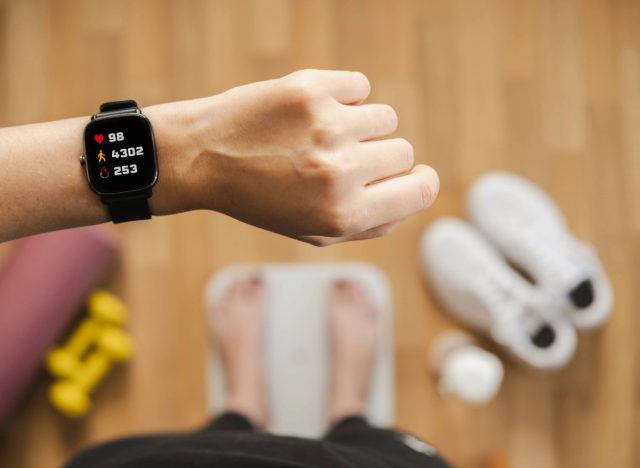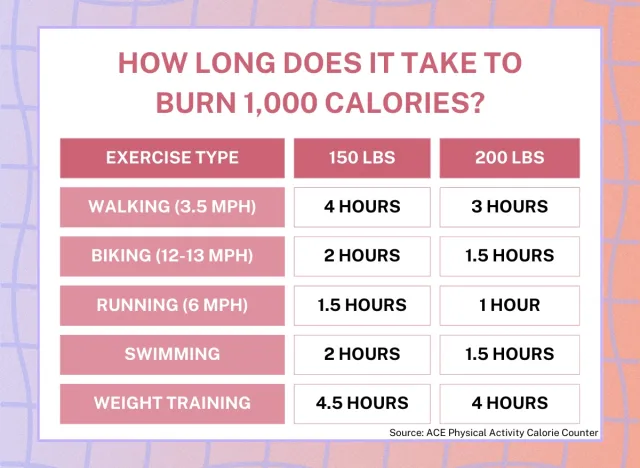Burning 1,000 calories a day might sound like a lofty goal, but it’s not as far-fetched as it seems. Whether you’re an athlete looking to boost performance or someone looking to shed extra pounds, understanding how calorie burning works is essential for reaching your health and fitness goals. That’s why we spoke with certified personal trainers and fitness experts who explain how you can burn 1,000 calories a day through regular exercise and increased daily activity, making it an achievable goal regardless of your fitness level.
Increasing your daily calorie expenditure can accelerate weight loss, improve cardiovascular health, and boost overall fitness. Additionally, torching more calories can ramp up your metabolism, helping you maintain a healthy weight. However, it’s crucial to approach your calorie-burning goals with a balanced perspective and a well-structured plan. Pushing yourself too hard, not recovering between workouts, and poor nutrition habits can thwart your calorie-burning efforts, potentially leading to injuries and burnout. That’s why health and fitness experts stress the importance of incorporating rest days into your routine and eating a balanced diet rich in essential nutrients.
Now, let’s explore how you can burn 1,000 calories a day, along with practical tips and expert advice on maintaining this goal in the long term.
What are calories, and how is calorie burn measured?

“Calories are units of energy used to measure the energy content of foods,” explains TJ Mentus, CPT, a certified personal trainer at Garage Gym Reviews. “The calories in food give your body the energy it needs to function and perform all the activities needed to stay alive, such as breathing, moving, and circulating blood. The excess is stored as fat when the body consumes more calories than it needs for energy. When caloric consumption is less than the body needs, it burns fat to make up the deficit that does not come from nutrition. A heart rate tracker is the best way to measure caloric burn since calorie burn is correlated with heart rate. This is because the heart rate increases, so does the need for oxygen, which requires more energy.”
RELATED: 10 Ways To Maximize Your Calorie Burn in Just 30 Minutes
Calorie burn is influenced by several factors, such as your Basal Metabolic Rate (BMR), which is the number of calories your body needs to maintain basic physiological functions at rest. According to the National Academy of Sports Medicine, your Total Daily Energy Expenditure (TDEE) includes BMR multiplied by a certain physical activity multiplier based on how much exercise you get a week. Factors like age, weight, gender, and activity level also significantly impact how many calories you burn daily.
Is burning 1,000 calories a day possible?

Burning 1,000 calories daily is possible, but the odds of success vary widely depending on your fitness level and body type. Physically active people and those with larger bodies or more muscle mass may find burning 1,000 calories easier than those who are sedentary, smaller in size, or lacking muscle.
“A typical strength workout will burn 300 to 400 calories in one hour on average,” says Mentus. “One hour of running will burn between 600 to 700 calories. Looking at those two typical forms of exercise, you will need to exercise at least two hours a day, which may not be realistic for most people. Unless you’re already in good shape, I would not suggest going right into two hours of working out as you will place yourself at a higher risk of burnout and possible injury.”
How long do you have you have to exercise to burn 1,000 calories?

Again, the time required to burn 1,000 calories varies widely based on body type, age, fitness level, and the form of exercise.
“Higher intensity activities generally burn more calories,” says Kyrie Furr, CPT, a certified personal trainer and performance coach with Barbend. “For example, high-intensity interval training (HIIT) workouts can vary widely in intensity, but they typically involve alternating between bursts of high-intensity exercise and periods of rest or lower intensity.”
Furr points out that for many individuals, torching 1,000 calories may require a combination of exercises and physical activity scattered throughout the day rather than one long, intense workout.
Safety and risks of burning 1,000 calories a day:

Burning 1,000 calories a day is an ambitious goal with potential risks. Pushing yourself too hard can lead to overtraining and inadequate recovery time, potentially resulting in injuries, fatigue, and burnout. That’s why balancing intense workouts with proper nutrition, hydration, and rest is essential to continue exercising consistently and burning calories sustainably.
Before starting any new workout routine, speak with a fitness professional or your health care provider to help avoid injury and burnout while staying on track toward your health and fitness goals.

